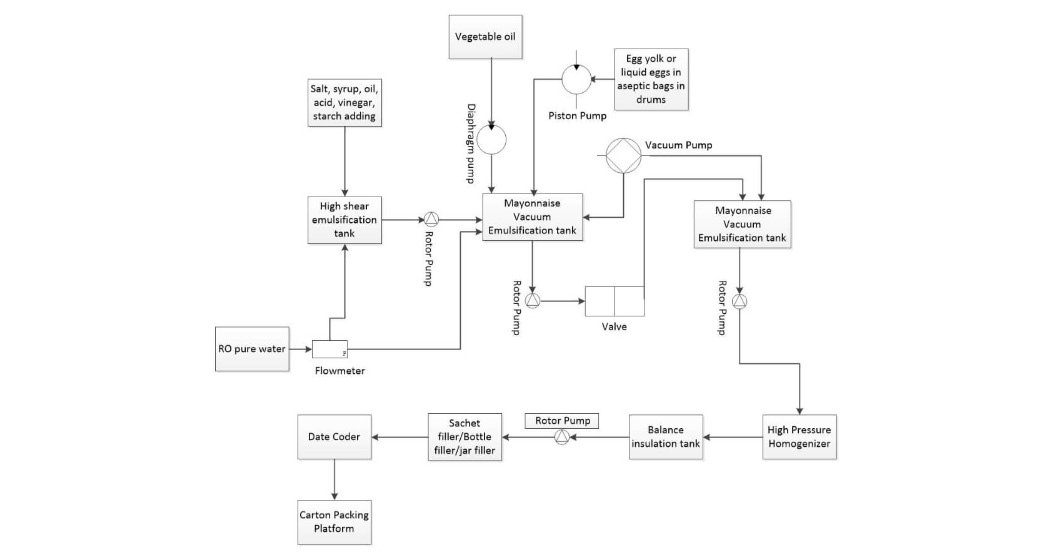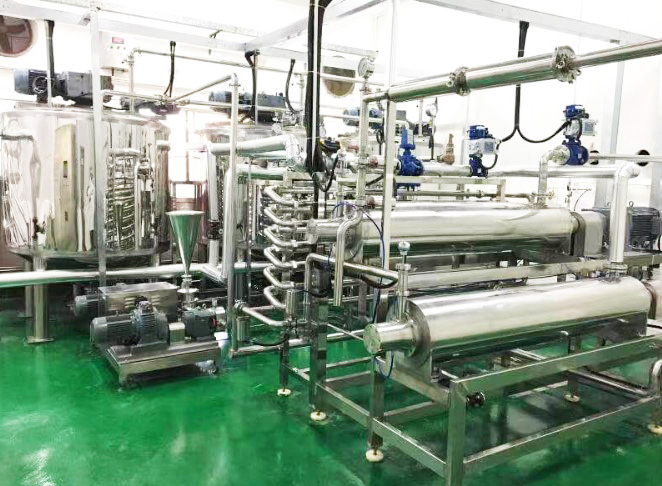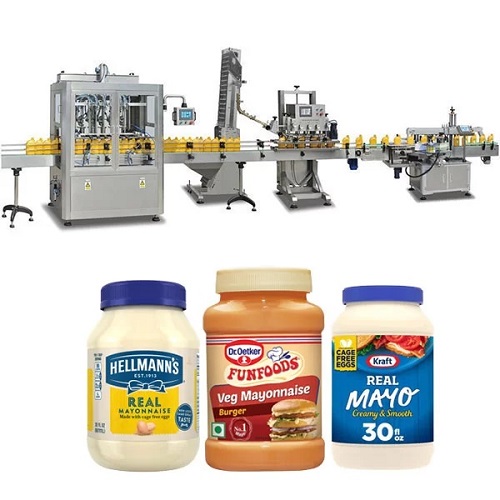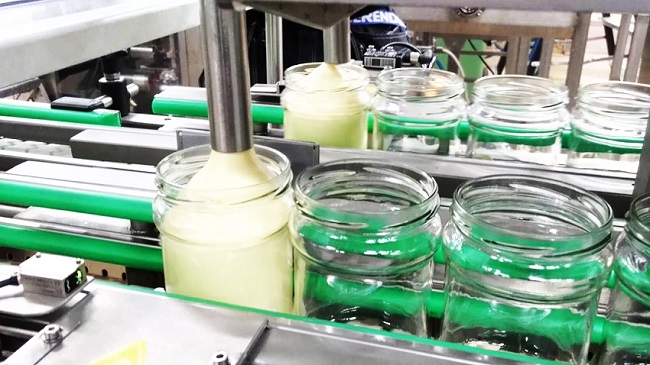Manufacturers of mayonnaise rely heavily on mayonnaise production lines to keep up with the increasing demand for a condiment in modern culture. Producing mayonnaise in massive amounts or on an industrial scale is doable with the help of a trustworthy mayonnaise machine. The mayonnaise making machine, also known as a vacuum emulsifier, pasteurization machine, and mayonnaise filling machine, are all significant examples of mayonnaise machines.
Mayonnaise Production Line Flow
All of the ingredients, like sugar, vegetable oil, vinegar, salt, lemon acid, and starch, will be emulsified and mixed in a high-shear emulsification tank before being sent through a rotor pump to a vacuum mixing tank. In the same way, the mixture of vegetable oil and egg yolk or liquid egg will be put into the mixing and emulsifying tank. Then, we’ll mix everything well over the next 20 to 30 minutes. We suggest a cold, vacuum-sealed method for mixing. At this point, we have the mayonnaise. We can make it smoother and taste better by homogenizing it and then filling it into sachets, bottles, or jars for an easy sale.

Mayonnaise Production Line Essential Machines
Mayonnaise Making Machine: Vacuum Emulsifier

Mayonnaise’s primary equipment is the vacuum emulsifier, which has the following qualities:
✔ Mixing, dispersing, emulsifying, homogenizing, vacuuming, heating, and chilling can all be in a single system.
✔ Effectiveness volumes are available between 100 and 2000 liters.
✔ Emulsifying heads installed on the top of the tank, with frequency conversion control on all mixers, create an internal process of emulsifying and homogenizing the liquid.
✔ This triple-walled tank may be used for either cooling or heating purposes by introducing a cold or hot medium.
✔ The lack of air and bubbles during the whole process of mixing and homogenizing in a vacuum system can make the final products last longer.
✔ SUS304 or SUS316L tanks are compatible with loading cells, which makes it easy to control the amounts of all ingredients.
✔ The mayonnaise machine has a maintenance hole, inlet, outlet for materials, a sample valve, a CIP cleaning ball, and an inlet and outlet for both cold and hot media in the emulsifier.
✔ The high-shear mixer acts as an anchor for stirring, thoroughly and effectively blending the oil with the other components.
✔ A production-efficient agitator system is advisable in the mixing tank. It must be possible to change the shear rate without affecting the flow. Quick emulsification requires high shear, while a coarse emulsion during oil input requires low shear.
Mayonnaise SSHE Pasteurization Machine

After vacuum emulsification, the mayonnaise is heated and cooled using the SSHE or Scrape Surface Heat Exchanger. Characteristics of the SSHE include:
✔ Excellent heat conduction.
✔ Compatible with materials with a high viscosity.
✔ Consistently scraping the surface to prevent sticking.
✔ The entire machine is built from SUS304/316L material and features CIP.
✔ Steam and hot water are heating mediums, and chilled water or glycol is the cooling media.
✔ Per cylinder, the heat exchange surface ranges from 0.08 to 1.40 m2.
Mayonnaise Filling Machine

After vacuum emulsification, this mayonnaise machine fills mayonnaise in small containers like jars, bottles, cans, or sachets to last longer—vacuum sealing for glass jars and metal cans. PET bottles are sealed with aluminum foil or liquid nitrogen after filling.
What You Need To Know About Mayonnaise Production Line
1. To keep the oil and water from separating when making mayonnaise, you need a mayonnaise machine for emulsification. We use vacuum emulsification equipment to do this. The high-shear mechanism of the multifunctional mixer makes it possible to make tiny oil droplets, stop microbubbles from getting stuck, and stop flocculation and precipitation. The mixer uses vacuum technology to include product materials below the liquid’s surface. This makes the emulsion come together quickly, with less clumping and less mixing with air and foaming.
2. Because the proteins in liquid egg yolk break down at temperatures above 65 degrees Celsius, the whole process of blending and making an even mixture must happen at a cool temperature of 5 degrees Celsius or less. When egg yolk is heated, it thickens, which makes it lose its ability to keep ingredients from separating.
3. Plant-based emulsifiers are also added to ensure the finished product is thoroughly mixed. The final texture of mayonnaise depends on how much oil and starch are in the mixture.

4. The raw materials processing technology of the mayonnaise machine can handle the liquid egg mixture and egg yolk necessary to manufacture mayonnaise. Because it is connected to a control system that maintains accurate ingredient weights and ideal storage conditions, automatic weighing equipment is dependable.
5. The design of the sanitary system guarantees that the mayonnaise machine mixer is wholly emptied between batches. This reduces waste, prevents product loss, and shortens the time it takes to clean. The effective cleaning-in-place (CIP) design of the sanitary mixer also makes it possible to improve the mixing quality and cut down on processing times.
6. Mix-proof valve installation is in place all along the manufacturing line to stop products from getting into the cleaning line and causing contamination or waste.
7. Small bottles and pouches may be filled with the finished mayonnaise on the line, which has a capacity of 500LPH to 5000LPH.
8. Because the process of making mayonnaise must be in a cold environment, ingredients like egg yolk or liquid egg must be pasteurized and kept in aseptic containers or cold places.
9. Some companies also pasteurize the mayonnaise after mixing the ingredients in a vacuum. Because the final products have a high viscosity, the SSHE pasteurizer will heat treat them.
10. Mayonnaise contains between 0.3 and 0.7 % acetic acid and has a pH of around 4.0. When vinegar and salt are added to water, the acetic acid level increases dramatically, making the water very resistant to the growth of microbes. So, the mayonnaise’s shelf life may still be about 2-6 months, even if it’s vacuum cold, emulsified, and packed without sterilization.
11. The emulsification and filling of the mayonnaise machine are both under vacuum conditions, which helps to prolong the product’s shelf life.

